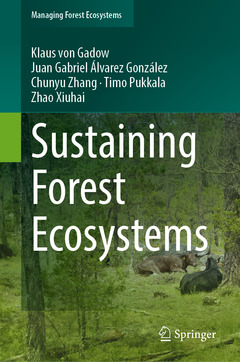What is a Forest?.-
Classification of Plant Communities.- Global Classifications.- Regional Classifications.- Potential Natural Vegetation.- Novel Forests.-
Popular Myths.- The Myth of the “Climax Community”.- The Myth of the “Primeval Forest”.-
Forest Anthromes: Domesticated Ecosystems.- To Act or not to Act?.-
Forest Assessment and Observation.-
Forest Assessment.- Some Selected Issues.- The Nested Plot Design.- Simulating a Test Area with Mapped Trees.- Seedlings, Saplings and Shrubs.- the Regeneration Circular Plot.- The Regeneration Neighborhood.- Generating a Sampling Schemen on a regular Grid.- An Example from Mongolia.- Remote Assessments.- Use of Airbornse Laser Scanning in Forest Inventory.- Numerical Delineation of Forest Stands.- Landsat.- Terrestrial Laser Scanning.- Estimating NPP based on MODIS.- Cost – Benefit Issues.-
Field Experiments.- Spacing Experiments for Planted Ecosystems.- Short-Rotation Coppice Experiments.- Ecosystem Functioning and Biodiversity Experiments.- Longitudinal, Cross-Sectional and Interval Studies.-
Continuous Forest Observation.- Early Observational Infrastructures.- New Forest Observational Studies.- China.- South Africa.- India.- Mexico.- Global Forest Observation.- Machine Learning.- Establishing an Observational Field Plot.- Assessment Protocols.- Presentation Standards.- Species Codes and Colors.- Plot Maps.- Plot Summaries.-
Analysing Forest Ecosystems.- Forest Density.- Measuring Forest Density.- Basal Area.- Leaf Area Index.- Stand Density Index.- Nilson’s Sparsity.- Relative Spacing.- Crown Competition Factor.- Patterns of Density.- Planted Forests.- Natural Forests.-
Forest Heterogeneity and Structure.- Species Diversity.- The Species-Area Relationships.- Non-Spatial Structure.- Unimodal Diameter Distributions.- Bimodal Diameter Distributions.- Specific Diameter-Height Relations.- Generalised Diameter-Height Relations.- Spatially Explicit Diameter-Height Relations.- Bivariate Diameter-Height Distributions.- Spatial Structure.- The Uniform Angle Index.- The Forest Ecosystem – A Mosaic of Neighborhoods.- Species Segregation and Mingling.- A System of Nearest Neighbor Statistics.- Implementing the Neighborhood System in R.- Extensions of the Mingling Concept.- Assessing Community Dissimilarity.- An Example using Taxonomic Distances.- Analysing Harvest Events.- Linguistic Variables.- Simple Numerical Variables.- Removal Preferences in a Spatial Context.- Simulating a Harvest Event.- The Gini Coefficient.- Reconstruction and Simulation.- Applications in Spatstat.- Developing your own R Code.- Simulating a Planted Forest.-
The Shape and Growth of Forest Trees.- The Shape of Forest Trees.- The Tree Crown.- Crown Models of Higher Resolution.- The Crown Window.- The Stem.- Stem Profile Functions.- The Brink Function.- Modeling Stem Quality.- The Root System.- Compatible Biomass Models.- Developing a System of Compatible Biomass Equations.- Individual Tree Growth Models.- Modeling Tree Survival.- Competition Effects and Response to Competition.- Overtopping Basal Area: BAL and BALMOD.- Local Crowding.- Area Potentially Available.- Overlapping Zones of Influence.- the KKL Index.- Distance-Weighted Size-Ratio (Hegyi).- Other Competition Indices.- Examples of Individual Tree Growth Models.- Selecting Trees for Harvest.- The Four-Forester Problem.- Spatial Thinning Models.-
Forest Production.- Site Models.- Site Index Systems based on Dominant Height.- A Site Index System based on the Guide-Curve Method.- A Site Index Systems based on the Algebraic Difference Equation Method.- Phytocentric and Geocentric Measures of Site Productivity.- Plant Communities.- Indicator Plant Species.- Climate Indices.- Soil Parameters.- Comparison of Methods.- Estimating Forest Production.- Estimating Element Content in Forest Production Models.- Production in Planted Forests.- Production in Continuous Cover Forests.- Forest Density and Production.- Examples of Forest Production Models.- A Fagus sylvatica Ecosystem.- A Eucalyptus grandis Ecosystem.- Estimating Production: No Observations.- Compatible Models of Growth and Production.- Transition Function for Tree Number Reduction.- Disaggregation involving Tree Diameters.- Disaggregation involving Height Estimation.- Output Functions.- Total and Merchantable Volume Estimation.- Biomass Distribution and Carbon Estimates.- Forest Production and Individual Tree Growth.- Modeling Harvest Events.- Separation Parameters.- Thinning Rules.-
Designing Forest Ecosystems.- Risks and Preferences.- Estimating Abiotic Risks.- Estimating Biotic Risks.- Establishing a Preference Order.- Constrained Optimization.- A Pulpmill with Boiler Constraint.- Afforestation and Water Yield.- Sustaining Planted Forests.- Classical Methods.- Age Class Simulation.- Multi-Period Harvest Scheduling.- Sustaining Continuous Cover Forests.- the Inverse J-shaped Liocourt Curve.- Optimum Residual Structures.- Sustaining Green Landscapes.- Cradle-to-Grave Design.- Multiple Path Design.- Heuristic Combinatorial Optimization.- Simulated Annealing.- Tabu Search.- Genetic Algorithm.- Ant Colony Optimization.- Decentralized Heuristics.- Using Stand Level Optimization in Forest Level Planning.- Spatial Heuristic Optimization.- Use of Small Spatial Units in Forest Planning.- Tree Level Planning.- Application Examples.- Indira Gandhi Canal Forests.- A Forest in Germany.- A Planted Eucalyptus Ecosystem.- A Coastal Dune Ecosystem.- A Mountain Ecosystem.- A “Novel Ecosystem”.- A Forest Farm.- Literature.- Index.




